
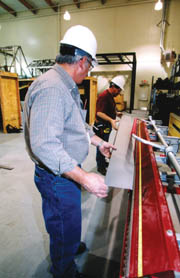
United Brotherhood of Carpenters’ International Training Center is a “train-the-trainer” facility, in which instructors receiving training may enjoy the comforts of dormitory-style living while receiving the training in skills they will, in turn, have to teach.
“The students who come to our training center come from all aspects of carpentry,” explains Jim Vodicka, coordinator for the training center. “What we can provide for our instructors is a total training package. The majority of the trainers are full-time instructors.”
Las Vegas was chosen as the sight for the two-year old facility for practical reasons: lowest air fares, no days lost to snow or inclement weather ... and who doesn’t want to go to Las Vegas?
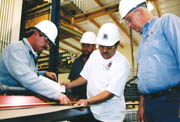
A more perfect union
The majority of union training used to be through the apprenticeship system. Many regional programs include journeymen training. Journeymen must complete so many hours of updated training to get a raise. The UBC now trains as many journeymen per year as apprentices.“Union members pay into the training fund, negotiated out of their wages, and that fund is set up to train journeymen and apprentices,” Vodicka explains. “It’s a joint committee that funds the apprenticeship training center, made up of contractors and union members.”
The average length of courses are five days at the center. Some courses are shorter or longer (two- or three-day some seven and there are even 14-day courses). Students come here from all areas of construction: millwrights, pile drivers, floor layers, interior system carpenters, residential carpenters—and likewise, the instructors teach all phases of carpentry.
In addition to the union, the manufacturers are also realizing the benefits of training trainers.
“Two weeks ago, we had an interior systems leadership conference,” Vodicka says. “Invited were contractors, interior system instructors, program coordinators, and USG and Armstrong put on workshops. We had about 300 people out there. Armstrong dealt with new seismic regulations for the ceiling industry and showed off new products. Of the 300, about 75 were contractors.”
Manufacturers may not always be set up to train properly, and even if they are, many may find it challenging to reach those who need the training. The UBC offers manufacturers the opportunity to train its trainers, thus qualifying UBC’s trainers to train its students in proper manufacturer specs, reaching the contractor audience it might not otherwise reach. Many materials are donated.
“We have USG, Radius Track, Flex-Ability Concepts, Ingersoll-Rand, Nathan Kimmel’s channel iron bender, we work with Armstrong with our acoustic ceiling class and drywall barrel ceiling class,” Vodicka adds. “Any time a manufacturer has a new product that requires training, they work with us. We already have the training facility, and we ask them for the knowledge and we will properly train in their methods. Manufacturers do more product-specific training and we want to know the proper way to install the manufacturer’s product. This means no callbacks and more productivity in the field. Callbacks mean lost money.”
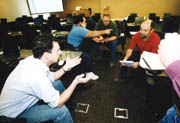
The next generation
The recurring theme that plagues so many trades is enticing new generations of skilled workers.“A lot of our programs have taken major steps to recruit kids out of high school but we are up against academia, and it is the colleges and universities that usually attract the best and brightest,” Vodicka adds. “We need some of those best and brightest kids.
“I talked to a mom at career day and she asked what we could offer her son. I said four years of training and after nine weeks, he will go to work with an OSHA card, ready to safely work on a job and start earning $12 an hour. Then he’ll be getting paid when he comes back to school. There is no catch! It costs about $100 in books, the only fee to start the apprenticeship program. One of our apprentices went through college but still loved his career working in residential construction.”
Vodicka feels one area of recruitment that might be strengthened is emphasizing the options of advancement. An apprentice can become a foreman, an estimator, contractor or a superintendent. He can be a union professional, a local president or organizer or he can teach for the training center. UBC cannot only act as a doorway but as a guide throughout a career. Some also go to work for manufacturers.
Teaching experienced construction veterans is another training area. Contrary to what one might think, training a journeyman isn’t always just “old dog, new trick.”
“We train in a non-threatening manner,” Vodicka says. “You don’t want to just test a journeyman—maybe he hasn’t been in a school in 20 years and it’s already a step for him to be here. You don’t want to make him feel out of place; you want him to feel comfortable. They need to see that what they are learning can translate into dollars. We can make them more productive by transferring years of learning in a short class.”
Even old dogs are receptive to new tricks when they mean potential profits.
“For example,” he continues,” I had a student in the grid class and when we showed him our way he said it wouldn’t work, it’s not the way he learned. I said it’s not the way I learned either! I asked him to build it my way on the first ceiling, and if not productive, to do it his way on the second ceiling. Halfway through, I heard a loud shout, went over, and he said, ‘I don’t believe this. This is so fast, so easy, why didn’t I get this before?’ I said, believe me, that’s why we’re doing this class.
“It is common for training to open their eyes. A guy not productive on the job is the first guy laid off. This means putting more money in their pockets. Now, this trained guy is of value to a contractor.”
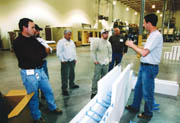
The center of attention
The philosophy behind the center is that it is set up to encourage social interaction among visiting instructors/students. A TV is out in a common area where students can socialize if they want to watch TV. Instructors learn as much from each other as from the courses and are encouraged to interact.“We’ve expanded our interior system training over the years,” Vodicka says. “A 70,000 square-foot shop area enables us to build a scaffold, leave it up for a while and tear it down. Most of our props can be stored once we’re finished. For framing, we can put down a plywood deck and put the plywood right on the concrete floor so we can drive a lift over it. This lets us screw things down and unscrew them.”
Vodicka showed a training area just for ceilings. The UBC is also working with industry associations to spread the knowledge.
“We’re working with the Insulated Concrete Form Association,” he says. “They wanted to work with carpenters on the association’s product because of the skills our people possess. The ICFA feels it cannot make the jump from residential to commercial without the help of union carpenter skills. If they sell a job, they come to us to find the best tradesmen. We also work with the Door and Hardware Institute and AWCI.”
Ron Warde, an instructor, from Carpenters, J.A.T.C., of Las Vegas, was teaching a lath ceiling class during the visit. These students are either familiar with this material and want new insights, or want to learn more about how to teach the subject at hand. Warde and his students spent some of the morning comparing notes on local politics.
“We discussed politics,” he says. “It’s so great to talk to people from coast to coast and learn how their area works.”
The students (remember, actually trainers themselves) discussed how often they’d like to get updated on training.
Mike Reed, of Portland, Ore., says, “I come twice a year since they opened this center to take different types of classes and get new curriculum to take back and teach my students.”
“This is actually my first trip here,” says Ron Robbins, also of Portland. “I’m really impressed with the center.”
John Marzoli, of N.J., comes about twice a year.
These three men train the actual carpenters in their respective locales. They believe things are going well with the workforce. Included among their students are journeymen, older guys trying to diversify their skills. In some cases, people are knocking down the door to get in, illustrated by first-year apprentices who may have worked non-union for 20 years.
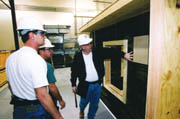
Evolution of the union
“When I got into the trade, you had to know someone in the trade to get in,” Vodicka says. “Now, we take the best qualified, no matter who they are or who they know. We take the best people for the job, accepting new integrity and accountability for what we do.“We are now organizing a lot of Hispanics,” he continues. “They are good people with a good work ethic, a hardworking group and they really like the trades. We are getting teachers to train them. We have material in Spanish and also French to address our Canadian brothers. The face of the industry is changing and we want to stay on the forefront of those changes.”
An enthusiastic face at the facility belonged to Kathy Swan, Ph.D., an industry consultant and union carpenter, of Tacoma, Wash. Swan is a positive presence with a contagious optimism. She expressed her own feelings on improving the workforce.
“We need an upward spiral,” Swan says. “The ‘us-against-them’ mentality of yesteryear is gone. This is a new union, freshly invigorated, and we need to have our contractors be successful and out-produce competitors, underbid, be on time and go on to have more successful projects.”
“The Brotherhood is not an adversarial relationship as it may have been in the past,” Vodicka explains. “Sometimes, a trade union is looked upon by the carpenter as an adversarial relationship between contractor and worker. We look at it as more of a partnership. Without contractors, our members don’t work and are out of business. They have concerns and we want to meet them and want them to make their concerns known to us.”
Regarding the negative opinion sometimes hurled at unions, Swan feels that these opinions are not usually based on fact. Once they see the profitability of a union-skilled workforce, they save dollars.
Another myth often aimed at unions is that union members take advantage of the shield a union can offer from employers to be lazier. The reality is quite the opposite.
Vodicka offers this explanation to illustrate: “To develop foreman training, we went to a state, helped organize the on-the-job training and said we would increase production by 50 percent. The fact is, union members are more productive, not less.”
The mission is simple, according to Vodicka: The Brotherhood is looking to improve the quality of every carpenter out there doing interior systems. The UBC is trying to work with manufacturers to learn the quickest, easiest and proper way to install new products. It is also looking at training members, whether journeymen or apprentices, the proper way to install and fasten manufacturer products properly.
“Every person swinging a hammer should be looked at as a union brother,” Vodicka says. “If putting up drywall, an acoustic ceiling, metal framing, machine setting, floor laying, pile driving, all these fall under the term, ‘carpenter.’”
For these carpenters, continuing career fulfillment is a trainer away.

Report Abusive Comment